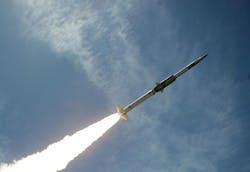Orbital to build 18 GQM-163A Coyote supersonic sea skimming target drones for U.S. Navy and allies
Officials of the Naval Air Systems Command at Patuxent River Naval Air Station, Md., announced a $52.9 million contract to Orbital on Monday to build 18 GQM-163A lot 12 full-rate-production Coyote supersonic sea skimming target base vehicles for the U.S. Navy and governments of Japan and Israel. The French navy also operates the GQM-163A.
The contract includes D6AC long-lead steel for the GQM-163A for the Navy, Japan, and Israel.
The GQM-163A Coyote supersonic sea skimming target is designed to provide an affordable target to simulate supersonic sea-skimming and other emerging supersonic anti-ship cruise missiles. It also supports research in ship-defense systems and fleet training.
The supersonic target drone is designed to help Navy ship crews learn to defend themselves against modern anti-ship missiles like the French Exocet and the Russian-made SS-N-22 Sunburn and SS-NX-26 Oniks, which may be operational with military forces in Iran, Syria, and other countries in the Middle East for use against U.S. and allied naval forces in and around the Eastern Mediterranean, Persian Gulf, and other vital waterways.
The Sunburn anti-ship missile can fly at three times the speed of sound, giving targeted vessels little time to react. It carries a 705-pound explosive warhead -- twice the destructive payload of the Exocet and three times as fast.
The Oniks missile, more advanced than the Sunburn, can fly as fast as Mach 2.5, and carries a 661-pound warhead. Not only is this missile far faster and more powerful than the Exocet, but it may have the capability to maneuver on its terminal flight to its target, which could make defeating it difficult, if not impossible.
The Sunburn and Oniks missiles have sufficient destructive payloads to pose serious threats to large U.S. warships like aircraft carriers, which are at the heart of U.S. power-projection strategies around the world.
Related: Leonardo launches medium-to-high-performance M-40 target drone at Paris Air Show
GQM-163A Coyote supersonic sea skimming target is a non-recoverable, supersonic aerial target, capable of speeds of Mach 2 or greater and altitudes from 13 to 66 feet above the surface of the ocean, Orbital officials say.
Orbital won a contract to develop the GQM-163A in 2000, and the target drone has been operational since 2005. In October 2014 the company won a $27.7 million Navy contract to build eight GQM-163A practice missiles.
The GQM-163A drone is designed to simulate sea-skimming cruise missiles by flying faster than twice the speed of sound as low as 12 feet off the surface of the ocean. The target drone also can simulate high-altitude cruise missile attacks that plunge down at ships from higher than 30,000 feet.
On this contract Orbital Sciences will do the work in Chandler, Ariz; Camden, Ark.; Vergennes, Vt.; Lancaster, Pa.; and Hollister, Calif.; and should be finished by May 2022. For more information contact Orbital Sciences www.orbital.com, or Naval Air Systems Command at www.navair.navy.mil.
Ready to make a purchase? Search the Military & Aerospace Electronics Buyer's Guide for companies, new products, press releases, and videos
